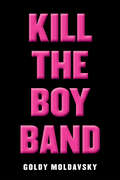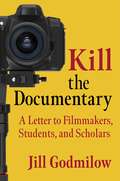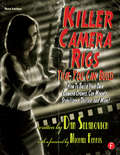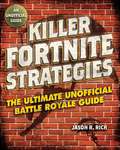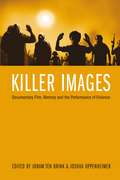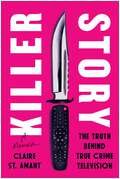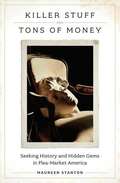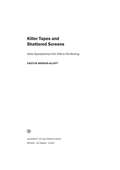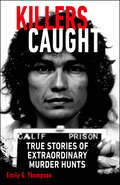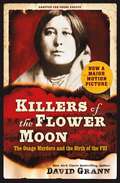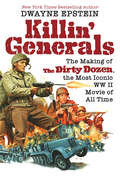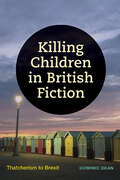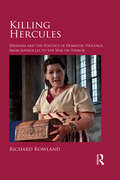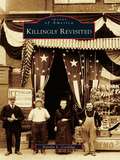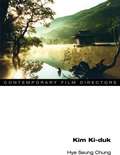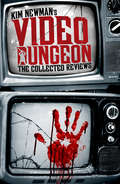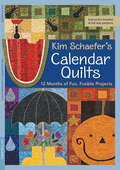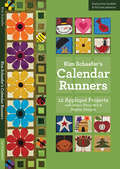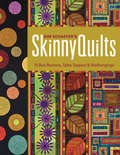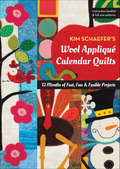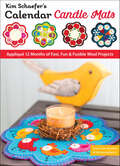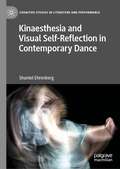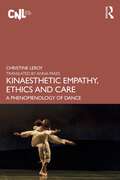- Table View
- List View
Kill the Boy Band (Point Ser.)
by Goldy MoldavskyThe New York Times–bestselling debut story of four superfan friends whose devotion to their favorite band has darkly comical and deadly results.Just know from the start that it wasn’t supposed to go like this. All we wanted was to get near them. That’s why we got a room in the hotel where they were staying.We were not planning to kidnap one of them. Especially not the most useless one. But we had him—his room key, his cell phone, and his secrets.We were not planning on what happened next. We swear.Praise for Kill the Boy Band“Moldavsky’s sharp, shocking debut is like no other.” —Entertainment Weekly“Fiercely entertaining . . . One of the smartest YA releases of the year.” —New York Daily News“Misery for the Belieber generation.” —Observer.com“Boy bands gets the Heathers treatment in this madcap macabre . . . A sendup of the artificiality of the fame-making machine from both sides, the novel’s humor is mercilessly black, and no one comes up smelling like roses.” —Kirkus Reviews“Wickedly funny.” —NPR.org“Bitingly satirical.” —Publishers Weekly“[For] anyone who’s ever had the fortune-or misfortune-of being a fan.” —Booklist “Hilarious . . . A must-have.” —School Library Journal
Kill the Documentary: A Letter to Filmmakers, Students, and Scholars (Investigating Visible Evidence: New Challenges for Documentary)
by Jill GodmilowCan the documentary be useful? Can a film change how its viewers think about the world and their potential role in it? In Kill the Documentary, the award-winning director Jill Godmilow issues an urgent call for a new kind of nonfiction filmmaking. She critiques documentary films from Nanook of the North to the recent Ken Burns/Lynn Novick series The Vietnam War. Tethered to what Godmilow calls the “pedigree of the real” and the “pornography of the real,” they fail to activate their viewers’ engagement with historical or present-day problems. Whether depicting the hardships of poverty or the horrors of war, conventional documentaries produce an “us-watching-them” mode that ultimately reinforces self-satisfaction and self-absorption.In place of the conventional documentary, Godmilow advocates for a “postrealist” cinema. Instead of offering the faux empathy and sentimental spectacle of mainstream documentaries, postrealist nonfiction films are acts of resistance. They are experimental, interventionist, performative, and transformative. Godmilow demonstrates how a film can produce meaningful, useful experience by forcefully challenging ways of knowing and how viewers come to understand the world. She considers her own career as a filmmaker as well as the formal and political strategies of artists such as Luis Buñuel, Georges Franju, Harun Farocki, Trinh T. Minh-ha, Rithy Panh, and other directors. Both manifesto and guidebook, Kill the Documentary proposes provocative new ways of making and watching films.
Killer Camera Rigs That You Can Build: How to Build Your Own Camera Cranes, Car Mounts, Stabilizers, Dollies, and More!
by Dan SelakovichThe singular beauty of this book is that Mr. Selakovich has successfully dedicated himself to producing clarity with every page." - Michael Ferris, Camera Operator/DP (Die Hard) For filmmakers who like to shoot their films with a mobile camera withough spending a fortune on equipment rentals, this book is a great gift indeed. I highly recommend it for its clarity and common sense." - Kris Malkiewica, Cinematographer/Author Don't buy or rent your fillm equipment-build it! Construct professional-quality camera rigs on your own with this comprehensive, step-by-step guide and stop wasting your money on overpriced equipment rentals and purchases! Dan Selakovich guides you through the creation of jibs, dollies, cranes, car-mounts, sandbags, tripods, and more. Features include: Build inexpensive but reliable and sturdy rigs-including cranes, dollies, stabilizers, car-mounts, and more; most for much less than $100!Includes over 2,000 photographs with clear step-by-step instructions, safety guidelines, material lists, and tool lists for each rig. American standard and meric measurements included. Includes a companion web site: http://dvcamerarigs.com/
Killer Fortnite Strategies: An Ultimate Unofficial Battle Royale Guide
by Jason R. RichMaster Strategies for Achieving #1 Victory RoyaleKiller Fortnite Strategies: The Ultimate Unofficial Battle Royale Guide is an all-new, full-color, unofficial guide for adult gamers specifically covering the Windows PC and Mac versions of Fortnite: Battle Royale. With pro tips, expert strategies, and in-depth information, this guide covers everything from tweeking your computer and customizing your keyboard for your own personal game play experience to advanced tactics for resource gathering and weapon utilization. Features: Hundreds of full-color screenshots Customizing tips for the ultimate gaming experience Thorough exploration of the island In-depth information on weapons, ammo, and loot items Proven strategies for resource gathering and building structures Expert combat and survival tactics Tips for avoiding the storm and surviving the End Game (the Final Circle) And more! Regardless of your skill or experience level playing Fortnite: Battle Royale on a PC or Mac, this info-packed resource will up your game, improve your kill scores, and help you achieve #1 Victory Royale.
Killer Images
by Joram Ten Brink Joshua OppenheimerCinema has long shaped not only how mass violence is perceived but also how it is performed. Today, when media coverage is central to the execution of terror campaigns and news anchormen serve as embedded journalists, a critical understanding of how the moving image is implicated in the imaginations and actions of perpetrators and survivors of violence is all the more urgent. If the cinematic image and mass violence are among the defining features of modernity, the former is significantly implicated in the latter, and the nature of this implication is the book's central focus. This edited anthology brings together a range of newly commissioned essays and interviews from the world's leading academics and documentary filmmakers, including Ben Anderson, Errol Morris, Harun Farocki, Rithy Phan, Avi Mograbi, Brian Winston, and Michael Chanan. Contributors explore such topics as the tension between remembrance and performance, the function of moving images in the execution of political violence, and nonfiction filmmaking methods that facilitate communities of survivors to respond to, recover, and redeem a history that sought to physically and symbolically annihilate them
Killer Images: Documentary Film, Memory, and the Performance of Violence (Nonfictions)
by Joshua Ten Brink Joram OppenheimerCinema has long shaped not only how mass violence is perceived but also how it is performed. Today, when media coverage is central to the execution of terror campaigns and news anchormen serve as embedded journalists, a critical understanding of how the moving image is implicated in the imaginations and actions of perpetrators and survivors of violence is all the more urgent. If the cinematic image and mass violence are among the defining features of modernity, the former is significantly implicated in the latter, and the nature of this implication is the book's central focus. This book brings together a range of newly commissioned essays and interviews from the world's leading academics and documentary filmmakers, including Ben Anderson, Errol Morris, Harun Farocki, Rithy Phan, Avi Mograbi, Brian Winston, and Michael Chanan. Contributors explore such topics as the tension between remembrance and performance, the function of moving images in the execution of political violence, and nonfiction filmmaking methods that facilitate communities of survivors to respond to, recover, and redeem a history that sought to physically and symbolically annihilate them
Killer Story: The Truth Behind True Crime Television
by Claire St. AmantFollow a journalist and TV producer from 48 Hours and 60 Minutes as she carves out a career in the ruthless, knives-out world of true crime television . . . one killer story at a time.Serial killers. Homicidal spouses. Sociopathic criminals. Claire St. Amant has met them all. She spent nearly a decade in network television chasing the biggest true crime stories in the country, including the murder of Chris Kyle, plastic-surgeon-turned-murder-for-hire suspect Thomas Michael Dixon, the Parkland high school mass shooting, the disappearance of Christina Morris, and serial killer Samuel Little. Bringing a true crime story to network television requires quick thinking and tenacious stamina, and in her debut memoir, Claire offers true crime fans a rare in-depth look from the other side of the yellow tape. In Killer Story, readers will learn what it really takes to get these gripping cases on the air with insights such as: How it feels to share space with a dead-eyed murderer Which TV show has a reputation for &“eating their young&” How reporters win over skeptical cops and reluctant lawyers Why TV journalists are always racing against the clock—and competitor sabotage What happens when a district attorney decides journalists have committed a felony The unresolved crimes that still haunt Claire to this day This eye-opening look behind the scenes of true crime television offers an unforgettable read—and a window into the daily reality of investigative journalism.
Killer Stuff and Tons of Money
by Maureen StantonMillions of Americans are drawn to antiques and flea-market culture, either as Participants or as viewers of the popular Antiques Roadshow and American Pickers. This world has the air of a lottery, where a $20 purchase could net you six figures. Master dealer Curt Avery, star of Killer Stuff and Tons of Money, plays that lottery every day, and he wins it more than most. Occasionally he gets lucky, but more often he draws on a deep knowledge of America's past and the odd, fascinating and beautiful objects that have survived it. Book jacket.
Killer Stuff and Tons of Money: An Insider's Look at the World of Flea Markets, Antiques, and Collecting
by Maureen StantonOne dealer's journey from the populist mayhem of flea markets to the rarefied realm of auctions reveals the rich, often outrageous subculture of antiques and collectibles. Millions of Americans are drawn to antiques and flea-market culture, whether as participants or as viewers of the perennially popular Antiques Roadshow or the recent hit American Pickers. This world has the air of a lottery: a $20 purchase might net you four, five, or six figures. Master dealer Curt Avery, the unlikely star of Killer Stuff and Tons of Money, plays that lottery every day, and he wins it more than most. Occasionally he gets lucky, but more often, he draws on a deep knowledge of America's past and the odd, fascinating, and beautiful objects that have survived it. Week in, week out, Avery trawls the flea and antiques circuit-buying, selling, and advising other dealers in his many areas of expertise, from furniture to glass to stoneware, and more. On the surface, he's an improbable candidate for an antiques dealer. He wrestled in high school and still retains the pugilistic build; he is gruff, funny, and profane; he favors shorts and sneakers, even in November; and he is remarkably generous toward both competitors and customers who want a break. But as he struggles for a spot in a high-end Boston show, he must step up his game and, perhaps more challenging, fit in with a white-shoe crowd. Through his ascent, we see the flea-osphere for what it truly is-less a lottery than a contact sport with few rules and many pitfalls. This rich and sometimes hilarious subculture rewards peculiar interests and outright obsessions-one dealer specializes in shrunken heads; another wants all the postal memorabilia he can get. So Avery must be a guerrilla historian and use his hard-earned knowledge of America's past to live by and off his wits. Only the smartest survive in one of America's most ruthless meritocracies. Killer Stuff and Tons of Money is many things: an insider's look at a subculture replete with arcane traditions and high drama, an inspiring account of a self-made man making his way in a cutthroat field, a treasure trove of tips for those who seek out old things themselves, and a thoroughly fresh, vibrant view of history as blood sport.
Killer Tapes and Shattered Screens
by Caetlin Benson-AllottSince the mid-1980s, US audiences have watched the majority of movies they see on a video platform, be it VHS, DVD, Blu-ray, Video On Demand, or streaming media. Annual video revenues have exceeded box office returns for over twenty-five years. In short, video has become the structuring discourse of US movie culture. Killer Tapes and Shattered Screens examines how prerecorded video reframes the premises and promises of motion picture spectatorship. But instead of offering a history of video technology or reception, Caetlin Benson-Allott analyzes how the movies themselves understand and represent the symbiosis of platform and spectator. Through case studies and close readings that blend industry history with apparatus theory, psychoanalysis with platform studies, and production history with postmodern philosophy, Killer Tapes and Shattered Screens unearths a genealogy of post-cinematic spectatorship in horror movies, thrillers, and other exploitation genres. From Night of the Living Dead (1968) through Paranormal Activity (2009), these movies pursue their spectator from one platform to another, adapting to suit new exhibition norms and cultural concerns in the evolution of the video subject.
Killers Caught: True Stories of Extraordinary Murder Hunts
by Emily G. ThompsonThey thought they had gotten away with murder. They were wrong.Discover the vital clues, the crucial evidence, the lucky breaks, the chases, the painstaking detective work, the unlikely heroes that led to the capture of serial killers such as &“The Good Nurse&” poisoner Charles Cullen, finally detected by a young colleague; Yorkshire Ripper Peter Sutcliffe, revealed by false license plates; Night Stalker Richard Ramirez, spotted by a 13-year-old boy; Hotelier of Death H. H. Holmes, apprehended selling his victims&’ skeletons…Killers Caught reveals the downfall of these ruthless individuals, as well as the stories of how many more of crime&’s most notorious and prolific murderers were brought to justice.
Killers of the Flower Moon: The Osage Murders and the Birth of the FBI
by David GrannThe New York Times bestseller and the Edgar Award for Best Fact Crime winner Killers of the Flower Moon is now adapted for young readers.**KILLERS OF THE FLOWER MOON IS SOON TO BE A MAJOR MOTION PICTURE DIRECTED BY MARTIN SCORSESE STARRING LEONARDO DICAPRIO AND ROBERT DE NIRO** This book is an essential resource for young readers to learn about the Reign of Terror against the Osage people – one of history's most ruthless and shocking crimes. In the 1920s, the richest people per capita in the world were members of the Osage Nation in Oklahoma, thanks to the oil that was discovered beneath their land. Then, one by one, the Osage began to die under mysterious circumstances, and anyone who tried to investigate met the same end. As the death toll surpassed more than twenty-four Osage, the newly created Bureau of Investigation, which became the FBI, took up the case, one of the organization's first major homicide investigations. An undercover team infiltrated the region, struggling to adopt the latest modern techniques of detection. Working with the Osage, they began to expose one of the most chilling conspiracies in American history.In this adaptation of the adult bestseller, David Grann revisits his gripping investigation into the shocking crimes against the Osage people.
Killin' Generals: The Making of The Dirty Dozen, the Most Iconic WW II Movie of All Time
by Dwayne EpsteinAn explosive inside look at The Dirty Dozen, the star-studded war film that broke the rules, shocked the critics, thrilled audiences, and became an all-time, cult-movie classic . . . The year was 1967. A cinematic blockbuster exploded across American popular culture. The Dirty Dozen didn&’t just reinvent the &“men on a mission&” war story, it blew the genre to pieces. Like its ragtag team of crazies, murderers, and misfits, it defied authority, mocked the military, and still managed to deliver action, adventure, and no-holds-barred Nazi-killing. It also received four Oscar nominations, launched the careers of many Hollywood legends, and inspired generations of filmmakers like Sam Peckinpah, Quentin Tarantino, and James Gunn. Based on exclusive interviews with the surviving cast and crew, friends and families of the stars, and other Hollywood insiders, Killing Generals is a riveting must-read for film buffs, military fans, and anyone who loves a down-and-dirty adventure tale. To quote the character played by Charles Bronson, &“Boy oh boy—killing generals could get to be a habit with me.&” Detailed, insightful, and gossipy, Epstein&’s homage spotlights the movie&’s endless barrage of cinematic gold. During a time when America was reeling from turmoil—the Vietnam War, civil rights protests, social upheaval—Hollywood held an indelible mirror up to a changing society. Films like Bonnie and Clyde, The Graduate, Guess Who&’s Coming to Dinner, Cool Hand Luke, and In the Heat of the Night would define the era. But it was a gritty, violent, darkly comic World War II movie called The Dirty Dozen that would really strike a chord with audiences—and become the year&’s biggest box office success. Heading up the all-star cast were Lee Marvin, Ernest Borgnine, John Cassavettes, Charles Bronson, Donald Sutherland, Jim Brown, Robert Ryan, Clint Walker, and at his most terrifying best, Telly Savalas, propelling many of them to stardom. More than a viewing companion to an iconic film, Killin&’ Generals brings to vivid life a pivotal epic in American history and pop culture, when going to the movies—in person—was a way of life shared by millions.
Killing Children in British Fiction: Thatcherism to Brexit
by Dominic DeanThis book stems from a simple yet disturbing observation: contemporary British fiction is full of children killing or being killed. Thoughtfully considering novels and films, alongside actual murder cases and moral panics, Dominic Dean develops this insight into a complex account of British cultural history, from the Thatcher to Brexit eras. Killing Children in British Fiction argues that the figure of the child provides means for negotiating, and hence for understanding, recent crises in Britain and their intersections with broader transnational conflicts. The book explores works from major British authors such as Kazuo Ishiguro, Ian McEwan, Doris Lessing, Sarah Waters, Alan Hollinghurst, and Peter Ackroyd; emerging writers such as David Szalay and Melissa Harrison; and filmmakers, including Stanley Kubrick, Nicholas Roeg, Robin Hardy, Derek Jarman, and Remi Weekes. Bridging and often challenging existing scholarship in childhood studies, literary studies, psychoanalysis, and critical and queer theory, Dean shows how the child, at once materially present and representative of an insecure future, can provoke relentless fantasies, fears, and, most troublingly, acts of real violence by adults.
Killing Hercules: Deianira and the Politics of Domestic Violence, from Sophocles to the War on Terror
by Richard RowlandThis book offers an entirely new reception history of the myth of Hercules and his wife/killer Deianira. The book poses, and attempts to answer, two important and related questions. First, why have artists across two millennia felt compelled to revisit this particular myth to express anxieties about violence at both a global and domestic level? Secondly, from the moment that Sophocles disrupted a myth about the definitive exemplar of masculinity and martial prowess and turned it into a story about domestic abuse, through to a 2014 production of Handel’s Hercules that was set in the context of the ‘war on terror’, the reception history of this myth has been one of discontinuity and conflict; how and why does each culture reinvent this narrative to address its own concerns and discontents, and how does each generation speak to, qualify or annihilate the certainties of its predecessors in order to understand, contain or exonerate the aggression with which their governors – of state and of the household – so often enforce their authority, and the violence to which their nations, and their homes, are perennially vulnerable?
Killingly Revisited
by Natalie L. CoolidgeIn the first volume, Killingly revealed the initial manufacturing emphasis in the town's villages. Killingly Revisited illustrates how the town survived after losing most of the textile industry, as it moved South, by actively seeking diversified commercial businesses. Within these pages, the town's fascinating past is displayed as newly acquired vintage views are coupled with information recently uncovered from the Killingly Historical and Genealogical Society's newspaper archives and other reference materials. In celebration of 300 years asan incorporated Connecticut town, the society is sharing photographs of Killingly's mills, businesses, buildings, churches, schools, andcemeteries. There have been losses from devastating fires that changed the face of Main Street. New streets and roads were added as modes of transportation changed. There are also new views of citizens at work and play.
Kim Ki-duk (Contemporary Film Directors)
by Hye Seung ChungThis study investigates the controversial motion pictures written and directed by the independent filmmaker Kim Ki-duk, one of the most acclaimed Korean auteurs in the English-speaking world. Propelled by underdog protagonists who can only communicate through shared corporeal pain and extreme violence, Kim's graphic films have been classified by Western audiences as belonging to sensationalist East Asian "extreme" cinema, and Kim has been labeled a "psychopath" and "misogynist" in South Korea. Drawing upon both Korean-language and English-language sources, Hye Seung Chung challenges these misunderstandings, recuperating Kim's oeuvre as a therapeutic, yet brutal cinema of Nietzschean ressentiment (political anger and resentment deriving from subordination and oppression). Chung argues that the power of Kim's cinema lies precisely in its ability to capture, channel, and convey the raw emotions of protagonists who live on the bottom rungs of Korean society. She provides historical and postcolonial readings of victimization and violence in Kim's cinema, which tackles such socially relevant topics as national division in Wild Animals and The Coast Guard and U.S. military occupation in Address Unknown. She also explores the religious and spiritual themes in Kim's most recent works, which suggest possibilities of reconciliation and transcendence.
Kim Newman's Video Dungeon
by Kim NewmanRipped from the pages of Empire magazine, the first collection of film critic, film historian and novelist Kim Newman’s reviews of the best and worst B movies. Some of the cheapest, trashiest, goriest and, occasionally, unexpectedly good films from the past 25 years are here, torn apart and stitched back together again in Kim’s unique style. Everything you want to know about DTV hell is here. Enter if you dare.
Kim Schaefer's Calendar Quilts: 12 Months of Fun, Fusible Projects
by Kim SchaeferCreate 12 seasonal wall quilts to hang in your home throughout the year with these projects from the bestselling author of Cozy Modern Quilts.These charming wall quilts are quick and easy to make for yourself and more for gifts. Transferring appliqué designs is a snap with this handy package of full-size patterns. Signature colors and motifs from best-selling author, Kim Schaefer. Darling images combine piecing and fusible appliqué. Start a family tradition that you'll enjoy all year 'round by making these adorable wall quilts. Hang a new one in your home each month! Smile with your cheery snowman in the winter, laugh at the mischievous ants crawling through your summer picnic, and get your apple ready for the teacher in the fall.
Kim Schaefer's Calendar Runners: 12 Appliqué Projects with Bonus Place Mat & Napkin Designs
by Kim SchaeferSet a festive table all year round with 12 seasonal table runner, placemat, and napkin patterns, by the bestselling author of Bright & Cozy Modern Quilts. These charming table decorations are so quick and easy to make, you’ll want to show off a different one for every month of the year. Calendar runners make great gifts too, for housewarmings, holidays, and other occasions. Pattern pack includes full-size patterns and instruction booklet. Fast fusible appliqué means you can dress up your table in no time. Complement your table décor with Kim Schaefer’s coordinating Calendar Quilts wall hangings.
Kim Schaefer's Skinny Quilts: 15 Bed Runners, Table Toppers & Wallhangings
by Kim SchaeferMake the most of narrow spaces with these 15 quilting projects that use appliqué and piecing techniques, by the author of Quilts from Textured Solids.Skinny quilts put the spotlight on narrow spaces with surprising splashes of color and personality. These quick projects are a great way to bring your scrap stash to life and accent a tabletop or other slice of space with pizazz. Bestselling author Kim Schaefer’s latest book features fifteen fun projects, using both applique and piecing techniques in a variety of color palettes and styles. Easy to do and perfect for last minute gifts and décor.
Kim Schaefer's Wool Appliqué Calendar Quilts: 12 Months of Fast, Fun & Fusible Projects
by Kim SchaeferEnjoy wool appliqué all year long with the 12 whimsical quilt projects in this sequel to Kim Schaefer’s Calendar Quilts.Start a family tradition by hanging a new mini quilt in your home each month! Twelve seasonal wall quilts—one for each month of the year—are perfect for quick projects, gifts, scrap-busting, and block-of-the-month clubs. Cheerful motifs in Kim’s signature style come with full-size appliqué patterns. Each block in this pattern pack measures 10 1/2” x 18 1/2”.Includes links to printable, full-size patterns
Kim Schaefer’s Calendar Candle Mats: Appliqué 12 Months of Fast, Fun & Fusible Wool Projects
by Kim SchaeferSew quick wool appliqué gifts and home decor In the tradition of best-selling author Kim Schaefer’s Calendar Quilts comes the perfect pattern pack for lovers of easy wool appliqué. Sew 12 darling candle mats to celebrate every month of the year! Finishing at just 9 inches across, these mini table mats can be used for holiday table settings to welcome each season. From Jack o’ lanterns and Easter bunnies to Christmas trees and conversation hearts appliqued on scallop-edged wool felt, the calendar can’t get any cuter! Start a family tradition you can enjoy year-round with quick-sew projects that are perfectly suited to block of the month classes and project kits. With fast fusible appliqué and wool embroidery, you can make one or make them all! Sew adorable! Make 12 wool appliqué candle mats for year-round enjoyment Combine fusible appliqué and wool embroidery for quick, heartfelt gifts Best-selling author Kim Schaefer’s motifs are perfectly suited to classes and kits
Kinaesthesia and Visual Self-Reflection in Contemporary Dance (Cognitive Studies in Literature and Performance)
by Shantel EhrenbergKinaesthesia and Visual Self-reflection in Contemporary Dance features interviews with UK-based professional-level contemporary, ballet, hip hop, and breaking dancers and cross-disciplinary explication of kinaesthesia and visual self-reflection discourses. Expanding on the concept of a ‘kinaesthetic mode of attention’ leads to discussion of some of the key values and practices which nurture and develop this mode in contemporary dance. Zooming in on entanglements with video self-images in dance practice provides further insights regarding kinaesthesia’s historicised polarisation with the visual. It thus provides opportunities to dwell on and reconsider reflections, opening up to a set of playful yet disruptive diffractions inherent in the process of becoming a contemporary dancer, particularly amongst an increasingly complex landscape of visual and theoretical technologies.
Kinaesthetic Empathy, Ethics and Care: A Phenomenology of Dance
by Christine LeroyKinaesthetic Empathy, Ethics and Care develops a philosophy of dance that highlights the psychological, aesthetic and ethical significance of dancer-viewer interaction in the moment of performance.Leroy draws on phenomenology, psychoanalysis, dance studies and care ethics to analyse kinaesthetic empathy as a form of intersubjective performance. She shows how, in the contagion or interweaving between corporealities of dancer and viewer, each party supports or upholds the other in a process of mutual care. Dance movement involves a play with gravity which alleviates the weight of repressed desire and redefines the contours of the body-image, facilitating psychological self-repair. Through projection into the body of another, we can develop our independence and autonomy as subjects, even in the midst of relational being. Richly illustrated with theatre dance examples, Leroy’s argument develops a corporeal basis for ethics and reveals how a return to the moving body through dance helps lay the foundations for a more humane society.This book will interest philosophers, dance researchers, care ethicists and care practitioners, as well as advanced students in these fields and general readers curious about the aesthetic and ethical potency of theatre dance.
